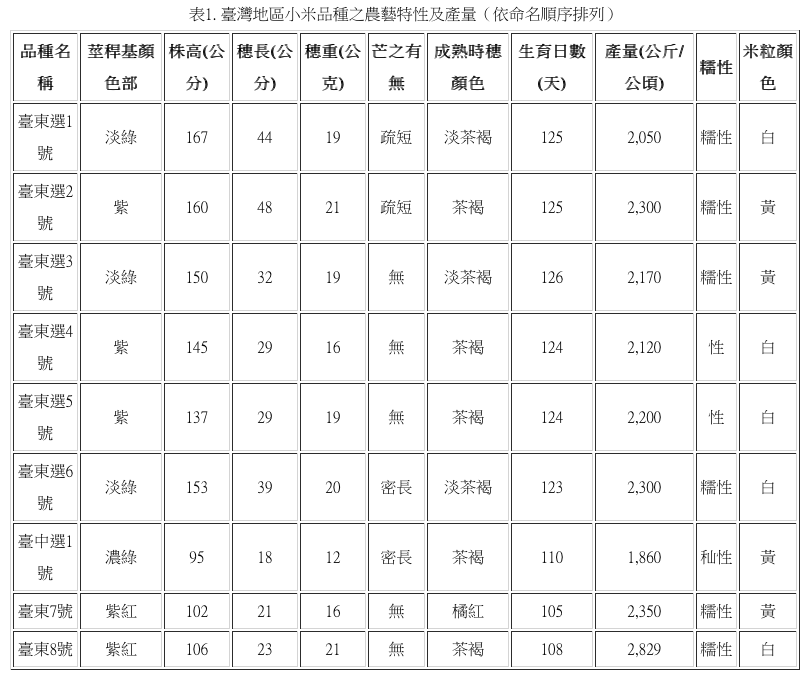What is the shape and taste of millet? How long is the growth period of millet?
Do you know Xiaomi? Do you know what the type of millet is? When is the childbearing period? Let's take a look.
Millet is a kind of millet. Xiaomi, which is native to China, is evolved from green foxtail grass (chromosome number 2n=18) and is easy to cross with each other. It is commonly said that the foxtail millet (Foxtail millet) cultivated at present is millet. The aboriginal people of Taiwan have a long history of cultivating millet, which is regarded as the oldest food crop and is of religious importance. All farming rituals are related to millet, and millet wine is an indispensable sacrifice for harvest sacrifices of all ethnic groups.
■ Taitung Millet Industry and Variety breeding
Because the millet varieties in Taiwan have been cultivated for a long time, most of them have been mixed and degraded, and most of them have been handed down from generation to generation by the aborigines of various places. Therefore, the improvement of millet varieties was carried out in this field in 1986, and after nearly a decade of selection, elimination and trial planting, six excellent varieties, including Taitongxuan No. 1 to No. 6, were selected and bred in 54, which increased the yield by 31.9% to 46.9% compared with the original mountain varieties. In 1949, Taichung District Agricultural improvement Farm also introduced breeding named Taichung No. 1, and in 1982, another excellent strain was selected and named Taitung No. 7. The new strain of TTS-8508, which has been selected for many years, was reviewed and approved by the Xiaomi Nomenclature Review Conference on October 31, 1997 and named "Xiaomi-Taitung No. 8". Xiaomi-Taitong 8 is a short panicle strain, which is short and tolerant to close planting, and has the characteristics of high grain yield and stable yield, fine white grain color, waxy rice quality and good taste, and its autumn cropping period is earlier than that of other varieties, convenient for harvest, and the yield is higher than that of the control variety Taitong 7.
At present, the related characters of various varieties of millet in Taiwan are shown in Table 1.

Type and growth period
(1) form
Root: millet root is fibrous root system, which is composed of primary root system and secondary root system. The primary root is derived from the seed after germination, and the water and nutrients are mainly supplied by the primary root at the seedling stage. When the condition is good at the 4-leaf stage, the secondary root can occur, the root system expands rapidly, it can go deep into the soil 150 cm, and the expansion radius is about 40 cm.
Stem: stem erect, about 60-150 cm long, Terete, with 10-25 stem nodes. The basal internodes are very short, from which tillers can be produced, which are called tillering nodes.
Leaves: 1 leaf per node, divided into leaves, ligule, pillow and other parts, without auricles. The leaf is 25-65 cm long, 2-4 cm wide, and long lanceolate. With the growth of the plant, the lower leaves lost their function one after another, and usually maintained 12-15 leaves in the peak growth period. The leaf sheaths and pillows of many varieties show different shades of purple because of anthocyanins, which can be used to identify varieties.
Spike: a terminal spike, paniculate. The length of the panicle is 10-30 cm, with branches on the rachis, with even opposite numbers and about 70-150 first-class branches per panicle, commonly known as panicle code. The spikelet has 2 glumes, two flowers inside, the lower floret degenerates, and the pistil of the upper complete flower has a pinnate stigma, three stamens, and one grain after insemination, with 3000 spikelets per spikelet. Some varieties of glumes and bristles show different shades of purple, which can be used for variety identification.
Grain: the grain of millet is caryopsis, about 1.5 mm long, 1.4 mm wide, 0.9 mm thick and 1.5 mm thick. The 1000-grain weight is 1.5 mm 2.5 g. After maturity, the glume has different colors such as white, yellow, red and black. After shelling, the millet has yellow, white, cyan and other colors.
(2) growth period
The number of millet growth days varies with different varieties. Those whose growth days are less than 110 days are early-maturing varieties, 111-125 days are medium-maturing varieties, and those more than 126 days are late-maturing varieties. Most of the millet varieties in Taiwan are medium-mature varieties.
Seedling stage: the line sprouts to grow permanent roots (secondary rooting), a new leaf can grow 1-5 days after seed germination, and permanent roots can be formed when the seedlings have 3-4 leaves when the soil is moist.
Jointing stage: the permanent root grows until the stem begins to grow, usually at the age of 10 leaves. During this period, the root system grows vigorously and the plant is the most drought-resistant, so the soil ventilation should be maintained at this time.
Booting stage: plant jointing to young panicle differentiation, general varieties begin 3-7 days after plant height, when roots, stems and leaves grow most vigorously, water and fertilizer demand surge, should be fully irrigated and fertilized, which is conducive to reproductive growth.
Heading date: the young spikelet entered the heading stage 20-25 days after differentiation, and it took 3-5 days from the top ear to full heading, and the spikelets blossomed 3-4 days after heading, avoiding rain and drought.
Grain formation stage: the sequence of grain filling is from the top of the ear to the base, and it takes 40 to 45 days from flowering to maturity. During this period, plants are neither drought-resistant nor water-resistant, so they should be given appropriate water and nutrients before heading stage, and be careful to prevent diseases and insect pests at the same time.
- Prev

Design of Wimbledon room system: Wimbledon room has high immunity? Wimbledon rooms should be more careful against highly infectious diseases and insect pests.
Wimbledon rooms seem to avoid many diseases and insect pests, in fact, more test the usual implementation of environmental health and safety, a little turtle hair, in order to grow sweet fruit. Let's take a look at it. Biosafety is not only a necessary basis for farms and poultry farms.
- Next

Agricultural product production and marketing resume verification is not the main axis, the farm management system is risky is the main axis?
Production and marketing resume verification, verification is not equal to textual research license, assessment of farm management risk is the main axis. Let's take a look. To obtain the production and marketing resume, the agricultural product label must be verified by a third party, audit and sampling are necessary procedures, and you have to pay extra, which makes the farmers
Related
- A one-day flower show brings 130 million yuan in orders! Nanhai, this Phalaenopsis exhibition is amazing
- What do the flower language and meaning of Lutheran tree mean? Precautions for planting Lutheran tree
- Encounter Chaoshan Kongfu tea, not without this cup of Phoenix single clump
- The durian market in Vietnam and Thailand is flooded. The price of imported durian has plummeted by 30-40% in a month.
- Shanghai solved the problem of local vegetable supply by planting 80,000 mu of green leafy vegetables.
- Wageningen University has become the best agricultural university in the world for the seventh time in a row.
- The strongest export season of South African grapes is full of challenges, with exports to Russia falling sharply by 21%.
- Sri Lanka is on the verge of bankruptcy, "Tea for debt" Organic Agriculture Revolution aggravates the Food crisis?
- Turning waste into earthworm manure and worm manure into organic fertilizer-A new choice for auxiliary farming
- Organic rice growers shoulder the responsibility of nurturing agricultural talents! Yinchuan Sustainable Farm with Organic Life Camp

